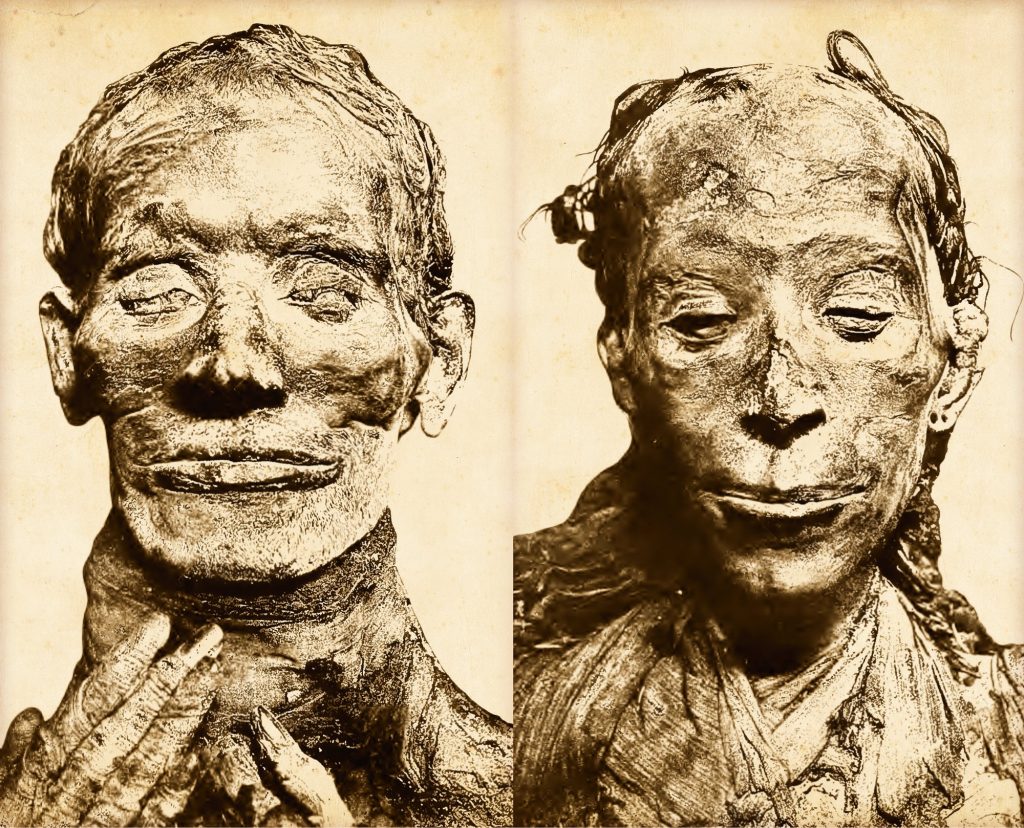In 1905, the sands of Egypt’s Valley of the Kings yielded a groundbreaking discovery that captivated historians and deepened the world’s understanding of ancient Egyptian nobility. British Egyptologist James Edward Quibell uncovered Tomb KV46, the final resting place of Yuya and his wife, Thuya. This tomb, considered “untouched” for centuries, provided extraordinary insights into the lives, rituals, and burial customs of Egypt’s elite, offering a perspective unlike any previously seen.
Yuya’s story is one of prominence and prestige. Hailing from the city of Akhmim, Yuya was no ordinary individual. He held several high-ranking titles, such as “King’s Lieutenant” and “Master of the Horse,” indicating his esteemed position in Egyptian society. Additionally, Yuya served as a prophet of the fertility god Min and acted as the “Superintendent of Cattle,” a role that highlighted his significant contributions to both the religious and economic realms of ancient Egypt. His tomb, brimming with opulent burial artifacts, reflected a level of respect and honor typically reserved for royalty, even though Yuya himself did not come from a royal lineage. This unique status underscores his remarkable influence and the high regard in which he was held within the pharaonic court.

Tomb KV46, discovered years before the famous unearthing of Tutankhamun’s burial chamber in 1922, was regarded as one of the most remarkable finds in the Valley of the Kings. Though it had suffered from looting during ancient times, the tomb still contained an impressive wealth of artifacts, and the exceptional preservation of the mummies added to its significance. The discovery included a diverse array of objects, such as statues, intricately designed furniture, and other luxurious items, painting a vivid picture of the aristocratic lifestyle enjoyed by Egypt’s upper class during the 18th Dynasty.
Among the treasures within the tomb, Yuya’s mummy stood out as an extraordinary relic of history. Its preservation was so remarkable that Sir Grafton Elliot Smith, a renowned anatomist, described it as one of the finest examples of embalming from the period. The remains revealed fascinating details about Yuya, believed to be a man in his 50s or 60s at the time of his death. His yellowish, wavy hair—likely bleached due to embalming substances—remained strikingly intact, as did many of his facial features. This preservation offered modern viewers an intimate and hauntingly personal connection to an individual who lived more than three thousand years ago.
The embalmers who prepared Yuya’s body displayed exceptional craftsmanship. His body cavity was filled with resin-soaked linen, a technique that contributed to the mummy’s enduring state. Yuya’s arms were crossed over his chest in a position of reverence, with his fingers meticulously extended. Even the details of his eyelids and eye sockets had been carefully attended to, showcasing the intricate and skilled funerary practices of ancient Egypt. These techniques provided not only a means of preserving the body but also a way of honoring the deceased, reflecting their beliefs in the afterlife and the significance of maintaining physical integrity for eternity.
Despite being raided in antiquity, Tomb KV46 retained a wealth of remarkable treasures. Among these was a partially strung necklace of gold and lapis lazuli beads found behind Yuya’s neck. This item offered a glimpse into the tomb’s original splendor and hinted at the hurried efforts of ancient grave robbers. Such artifacts, combined with other relics found in the tomb, highlighted the great care and attention afforded to Yuya and Thuya in their burial. These treasures also served as a testament to their legacy and the respect they commanded in life and death.
Yuya and Thuya’s mummies are particularly significant for their preservation of facial features. These features provide an extraordinary window into how they appeared in life, offering modern viewers a rare and almost personal connection to figures from ancient history. The mummies’ lifelike appearances make them more than mere archaeological finds; they become bridges to the past, inviting us to see the humanity of those who lived in an era so far removed from our own.
The discovery of Yuya and Thuya’s tomb has not only enriched the field of Egyptology but also captured the imagination of the public. Their story transcends time, serving as a reminder of the grandeur and complexity of ancient Egyptian civilization. The artifacts and remains from Tomb KV46 continue to intrigue scholars, shedding light on burial customs, social structures, and the cultural priorities of a society that placed immense value on honoring the dead.
More than a century after their discovery, Yuya and Thuya’s tomb remains a symbol of ancient Egyptian splendor. The remarkable preservation of their bodies and the treasures that accompanied them to the afterlife serve as enduring testaments to their prominence and the reverence with which they were treated. As we continue to study their lives and the context of their time, Yuya and Thuya provide invaluable insights into the rich tapestry of Egypt’s history.
This fascinating chapter in archaeology reminds us of the importance of preserving and understanding the past. Yuya and Thuya’s legacy is not just a story of wealth and status; it is a story of human connection, artistry, and the enduring desire to be remembered. Their tomb, a time capsule of ancient grandeur, invites us to reflect on the ways in which history shapes our understanding of humanity and the universal quest for immortality.





